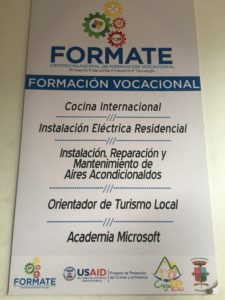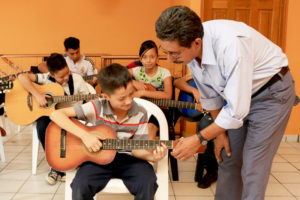[vc_row][vc_column][vc_column_text]
In El Salvador, 40 prevention tools and place-based focus create big changes for at-risk communities
By Jillian Slutzker
[/vc_column_text][/vc_column][/vc_row][vc_row][vc_column width=”2/3″][vc_column_text]
Q&A with Harold Sibaja, Chief of Party for the USAID-funded Crime and Violence Prevention Project
In Salvadoran communities once known for their peak levels of homicide, residents are now enjoying festivals in the streets, youth are attending vocational trainings and municipal actors are stepping up to prevent crime.

Behind these transformations lies a holistic crime and violence prevention project targeting some of the country’s most at-risk communities.
Known as the El Salvador Crime and Violence Prevention Project, the initiative deploys more than 40 prevention tools as part of six interactive strategies that address everything from a lack of employment opportunities to limited local capacity to track and prevent crime. It is funded by the U.S. Agency for International Development and implemented by Creative Associates International
Harold Sibaja, Chief of Party for the project, explains the project’s far-reaching approach, its focus on the most at-risk areas, and the biggest changes he has seen to date. Sibaja will also be speaking about the project at the Los Angeles Gang Prevention & Intervention Conference 2017 on May 1 and 2.
To learn more about the project, visit the special report: “From safe spaces to jobs: New approaches to crime and violence prevention.”
What makes the Crime and Violence Prevention Project particularly innovative?
Harold Sibaja: I think the most innovative thing about the project is the complementary nature of the project’s design and the variety of its prevention tools.

We are addressing 13 risk factors, all drivers of youth violence, through the implementation of 6 strategies and more than 40 prevention tools. Each strategy interacts with the other and offers a variety of tools that aim to mobilize groups of actors towards preventing youth violence and to offer youth opportunities to explore their talents, gain new skills and make better use of their free time.
You can see this in our six different strategies.
- Strategy 1 builds the capacity of local actors to address crime prevention.
- Strategy 2 offers youth with a variety of life skills and opportunities.
- Strategy 3 establishes safe havens for youth through Outreach Centers.
- Strategy 4 equips youth with vocational skills and employment opportunities.
- Strategy 5 recovers public spaces for youth to use in their free time and as a means to improve neighbor relations.
- Strategy 6 promotes alliances with the media, and raises awareness on violence in order to reduce risk factors and change from a culture of violence to a culture of peace.
What is the project’s “place-based approach”?
Harold Sibaja: The Crime and Violence Prevention Project works in 20 municipalities [out of 262 in the country] and across 122 communities. These municipalities and communities were selected as result of the high numbers of homicides they faced.
The project has been implementing a variety of primary prevention tools addressing different needs, and has just successfully tested a secondary prevention tool in one of them.
The Government of El Salvador, on the other hand, has selected 50 municipalities through its Plan El Salvador Seguro (Plan Safe El Salvador) focusing government efforts such as policing, health, education and other programs and coordination in the nation’s most violent municipalities. This government initiative first started working in 10 of these municipalities and is now expanding implementation to another 16.
Some of the Crime and Violence Prevention Project’s 20 selected municipalities are also Plan El Salvador Seguro municipalities. This allows for a more focused (or “place-based”) approach to crime and violence prevention from different actors.
How does the project focus efforts in a community through its place-based approach?

Harold Sibaja: Prior to starting implementation, the Crime and Violence Prevention Project assessed and selected intervention communities in all 20 municipalities. The different prevention tools are offered to these communities from strengthening the capability of community-based organizations to establishing Outreach Centers, improving public spaces and many others.
Also, the project has been strengthening 20 Municipal Prevention Committees, providing them with technical assistance, meetings space and equipment. These committees are expected to channel and coordinate all place-based municipal prevention efforts including those of the Crime and Violence Prevention Project and the Government of El Salvador.
Municipal Prevention Committees now meet at the Municipal Prevention Centers created and equipped by the project, which also house a number of municipal units created or strengthened by the project, including: Municipal Crime and Violence Observatories; Conflict Resolution Units; Youth and Gender Units; Sports Units; and others.
How does the project use data?
Harold Sibaja: Currently, a local university is finalizing an evaluation of the Crime and Violence Prevention Project’s 2014 to 2017 interventions across 12 municipalities selected at the beginning of the project in 2013. The evaluation includes surveys in 1,000 households across 12 municipalities.
Results of the survey will be compared with data from a similar survey conducted throughout 1,000 households in 2014. Data will be enhanced with interviews from municipal actors and beneficiaries interviewed in 2014 and again in 2017. This data will provide the project with information about its performance in the last two and a half years, and also highlight lessons learned and modifications required to ongoing programming.
In addition, the Crime and Violence Prevention Project tracks 25 indicators and collects quarterly data of all interventions through its Monitoring and Evaluation team and online database system, which measures progress on the project’s 40 prevention tools.
Moreover, the project manages an online Municipal Crime and Violence Observatory Information System, which provides current data on homicides, robbery, theft, domestic violence, extortion and sexual crimes across 20 municipalities.
Put together, these efforts and systems (Monitoring and Evaluation team efforts, along with the observatories information system) not only allows the project’s technical staff to measure progress, but also allows municipalities to develop policy and strategy proposals and programmatic tweaks to improve overall performance and effectiveness at the municipal and community level. In the end, these efforts ensure beneficiaries and municipalities as a whole become more secure, resilient and cohesive.
What have been the biggest changes you’ve seen in these communities since the project began?
Harold Sibaja: We’ve seen several big changes since the project began: a large number of municipal and local actors trained and involved in preventing crime; improved infrastructure (Outreach Centers, parks, sports facilities, vocational centers, Municipal Prevention Centers) that serves youth and municipal actors; and a large number of youth benefiting from the different programs that improve their skills and talents and allow them to access new opportunities.
Now, seeing neighbors out at night in selected communities is more palpable than it was two years ago.[/vc_column_text][/vc_column][vc_column width=”1/12″][/vc_column][vc_column width=”1/4″][vc_widget_sidebar sidebar_id=”sidebar-primary”][/vc_column][/vc_row]